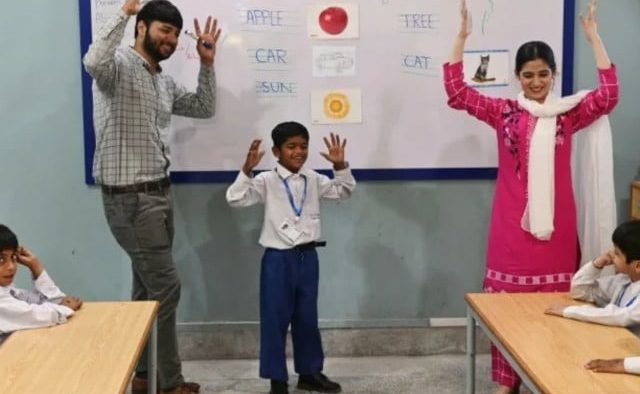School is life for Pakistani deaf youngsters

Students at a Pakistani school for the deaf have lively features and mischievous smiles, and they follow their sign language teacher’s hand movements with their hands.
The calm lessons, which are frequently taught by deaf professors, radiate happiness.
Qurat-ul-Ain, an 18-year-old deaf lady who started attending the school a year ago, stated, “I have friends, I communicate with them, joke with them, we share our stories with each other about what we have done and not done, we support each other.”
At this historic inner-city school in Lahore, more than 200 students, largely adults from underprivileged families, are among the few who are given a fresh zest for life.
Less than 5% of Pakistan’s more than a million school-age deaf youngsters attend formal education.
Girls’ rates are even lower, and many young people experience marginalization from both their family and society as a whole because they lack the words to express themselves.
“Life can be challenging at times. People in this area typically lack sign language skills, which creates a significant communication gap, according to Qurat-ul-Ain.
At the Deaf Reach charity school, students learn sign language in English and Urdu before moving on to the national curriculum.
In sign language, each person has a name that usually corresponds to a physical attribute.
Younger youngsters pick up information visually; an image is linked to a phrase and a sign.
When an answer is incorrect, their peers give the thumbs down; when it is correct, they make the applause sign (twisting hands).
Families that are learning to sign
Deaf Reach, an American nonprofit organization founded in 1998 and supported by donations, operates eight schools nationwide. It serves 2,000 students on a “pay what you can afford” basis, with 98 percent of the students receiving scholarships.
Most of the school’s pupils are from hearing families, who can also take advantage of the opportunity to learn sign language and help their child overcome communication barriers.
Adeela Ejaz talked about how difficult it was for her to accept that her 10-year-old first child was deaf.
The 35-year-old told AFP that he would hit his head against the wall and the floor when he couldn’t get his point across.
Everyone found it difficult because they were unable to converse with him. I wasn’t ready to accept that he is deaf, even though everyone would tell us that.
The mother-son duo is currently acquiring sign language skills.
“I am getting better at signing and can communicate with my son. He’s now become so attached to me.”
The program offers a phone app and an online dictionary, among other technological features.
Additionally, it has helped over 2,000 deaf persons get jobs with about 50 Pakistani businesses.
Huzaifa, 26, was placed in a stitching apprenticeship at Deaf Reach to assist him in breaking into the skilled industry after developing a fever at a young age that left him deaf.
The government school’s teachers were not proficient in sign language. They would scribble notes and instruct us to copy them from the board. He told AFP that “we used to get really disheartened” and “I would be really worried for my future.”
Prior to receiving official coaching, his family assisted him in learning the fundamentals of sign language as part of their push for him to get an education.
“My parents never abandoned me. They went above and above to ensure I could finish my schooling,” he remarked.
In the absence of their commitment, he declared, “I’d be working as a day laborer somewhere, cutting leaves or cementing walls.”
Fearful and alone
Sign language is different in every nation, has a distinct culture attached to it, and occasionally has regional variances.
According to the World Federation of the Deaf, 80% of the estimated 70 million deaf people worldwide do not have access to education.
Faizan, 21, who has worked at Deaf Reach for 11 years, said, “I used to sit idly at home, use the mobile, or play outside. I never had a clue about what people were saying.” Faizan hopes to work overseas.
I used to feel really weak psychologically, have an inferiority complex, and be afraid before I learned how to sign. Fortunately, though, none of that exists anymore.
In Pakistan, where laws prohibiting discrimination have been passed, attitudes toward individuals with disabilities are gradually improving.
“We have seen a tremendous shift in mentality over the years. Many people used to hide their deaf children out of embarrassment or shame,” said Daniel Marc Lanthier, head of operations at the organization that founded Deaf Reach.
Though there is still more work to be done, he noted that families are now coming out in the open and asking for their children’s education and jobs.
A million deaf children lack access to education, making it an enormous problem that must be accomplished.

I am a dedicated student currently in my seventh semester, pursuing a degree in International Relations. Alongside my academic pursuits, I am actively engaged in the professional field as a content writer at the Rangeinn website.








